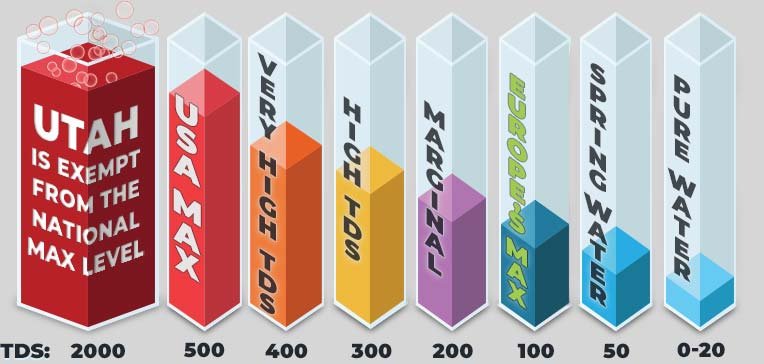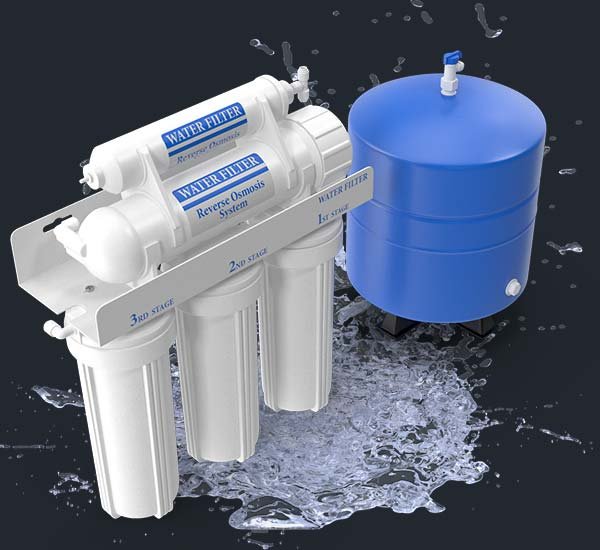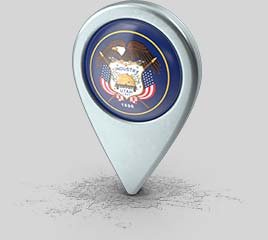Gastrointestinal Issues:
Diarrhea and Stomach Cramps: High levels of certain dissolved solids, such as sulfates, can cause gastrointestinal irritation, leading to diarrhea and stomach cramps.
Nausea: Excessive TDS, particularly from magnesium sulfate or sodium sulfate, can result in nausea.
Kidney Problems:
Kidney Stones: Elevated calcium levels in water can contribute to the formation of kidney stones in susceptible individuals.
Increased Kidney Load: High TDS can strain the kidneys as they work harder to filter out excess minerals and salts.
Cardiovascular Issues:
Hypertension: High sodium levels in water can contribute to increased blood pressure and hypertension, particularly in individuals who are sensitive to sodium.
Heart Disease: Prolonged exposure to high TDS levels, particularly from sodium, can increase the risk of heart disease.
Potential Toxicity:
Weakened Immune System:Continuous exposure to harmful dissolved solids can weaken the immune system, making the body more susceptible to infections and illnesses.
Bone and Joint Issues: Presence of toxic substances like lead, arsenic, and nitrates can lead to serious health problems, including developmental issues in children, reproductive problems, and an increased risk of cancer.
Heavy Metals: High TDS levels can indicate the presence of heavy metals such as lead, cadmium, arsenic, and mercury, which can be toxic and lead to various health issues, including neurological problems, developmental delays, and increased cancer risk.
Toxic Elements: The presence of toxic elements like arsenic can lead to severe health conditions such as skin lesions, cancers, and cardiovascular diseases.
Reproductive Health:
Fertility Issues: Certain dissolved solids, like nitrates, can affect reproductive health and have been linked to fertility issues.
Pregnancy Complications: High levels of nitrates and other contaminants in water can pose risks to pregnant women, including complications such as methemoglobinemia (blue baby syndrome) in infants.
Skin Conditions:
Dry Skin and Irritation: Water with high TDS can cause skin irritation, dryness, and exacerbation of skin conditions like eczema and psoriasis.
Allergic Reactions: Some individuals may experience allergic reactions or sensitivities to certain minerals and metals in high TDS water.

Total Dissolved Solids (TDS) in tap water refer to the combined content of all inorganic and organic substances dissolved in the water. These solids can include minerals, salts, metals, cations, and anions. TDS is typically measured in parts per million (ppm) and indicates the overall quality of the water..
Substances Contributing to TDS:
Calcium and Magnesium: Often responsible for water hardness.
Sodium and Potassium: Commonly found in water softeners and fertilizers.
Bicarbonates and Carbonates: Contribute to water alkalinity.
Sulfates and Chlorides: Often found in natural sources and industrial discharges.
Nitrates and Phosphates: Common in agricultural runoff.
Heavy Metals: Such as lead, arsenic, and mercury from industrial and mining activities.
Natural Sources:
Mineral Springs and Rock Weathering: Natural water sources like rivers, lakes, and groundwater can dissolve minerals from the soil and rocks through which they flow. This includes calcium, magnesium, potassium, and sodium.
Atmospheric Deposition: Rainwater can carry dissolved minerals and other substances from the atmosphere into water bodies, contributing to TDS levels..
Urban Runoff:
Stormwater Runoff: Water from urban areas can pick up various dissolved substances from roads, sidewalks, and other surfaces, including salts used for de-icing, oil, and heavy metals.
Sewage and Wastewater: Discharge from municipal sewage and wastewater treatment plants can add various dissolved substances, including nutrients and pharmaceuticals, to water sources.
Industrial Activities:
Manufacturing Processes: Industrial facilities can discharge wastewater containing dissolved chemicals, metals, and salts into nearby water bodies.
Mining Operations: Mining activities can release minerals and metals into water through leaching and runoff.
Household Sources:
Water Softeners: The use of ion-exchange water softeners can increase sodium levels in water as they replace calcium and magnesium ions with sodium ions.
Cleaning Products: Household cleaning products and detergents can dissolve in water and contribute to TDS.
Infrastructure:
Corrosion of Pipes: Aging and corroding pipes can release metals like iron, lead, and copper into the water supply, increasing TDS levels.
Water Treatment Processes: Some water treatment processes, such as chlorination, can add dissolved substances to the water.
Removing Total Dissolved Solids (TDS) and heavy metals from drinking water can be effectively achieved using several methods. Here are the most common and effective ones:
1. Reverse Osmosis (RO) Systems:
How it Works: Water is forced through a semipermeable membrane that blocks dissolved solids and contaminants, allowing only pure water to pass through.
Effectiveness: Highly effective at removing TDS, heavy metals (e.g., lead, arsenic, mercury), and other contaminants.
2. Distillation:
How it Works: Water is boiled to produce steam, which is then condensed back into liquid form, leaving most contaminants behind.
Effectiveness: Highly effective at removing TDS, heavy metals (e.g., lead, arsenic, mercury), and other contaminants.
3. Activated Carbon Filters:
How it Works: Water passes through a bed of activated carbon that adsorbs contaminants.
Effectiveness: Good for removing organic compounds, chlorine, and some heavy metals, but less effective for TDS.
4. Ion Exchange:
How it Works: Water passes through a resin that exchanges undesirable ions (e.g., calcium, magnesium, lead) with less harmful ions (e.g., sodium, potassium).
Effectiveness: Effective at removing certain heavy metals and reducing water hardness, but typically used in combination with other methods for TDS reduction.
5. Ultrafiltration:
How it Works: Water is pushed through a membrane with very small pores that block contaminants.
EEffectiveness: Effective at removing particles, some heavy metals, and pathogens, but not all TDS.

Tips for Choosing a System:
Water Quality Test: Conduct a water quality test to determine the specific contaminants present in your water.
Multiple Stages: Consider systems that combine multiple filtration stages (e.g., RO with activated carbon) for comprehensive removal.
Maintenance: Regular maintenance, such as changing filters and membranes, is crucial to ensure the system remains effective.
Installation and Usage:
Point-of-Use Systems: These systems, such as countertop or under-sink RO units, treat water at a single tap.
Whole-House Systems: These systems treat water as it enters the home, providing purified water to all taps.

Our water quality experts will show you exactly what contaminants are in your water with independent testing.
Combat Dry and Cracked Skin: The Impact of Hard Water and Soap over Usage.
Discover How Many Particles Your Family's Drinking Water Contains.
Reveal Your Water's Particles and How we can Eliminate those Toxins.
Reveals the difference between their water and filtered water - Consequence of doing NOTHING!
Identifying Toxins in Your Water: Empowering You to Choose What Stays or Goes.
Click the button below and complete our quick survey to get started with our water specialist!
Click to Schedule-Free Water Test-